|
Manglavites
The Manglabites or Manglavites (, ''manglabitai''; sing. μαγ[γ]λαβίτης, ''manglabitēs'') were a corps of bodyguards in the Byzantine Empire. Etymology Their name derives from the term ''manglabion'' (μαγγλάβιον, "cudgel") which was also used to designate the entire corps. The origin of the term itself is debated: one theory regards it as deriving from Arabic language, Arabic ''mijlab'' ("whip"), while another from Latin ''manus'' ("hand") and ''clava'' ("cudgel"). History The ''manglabitai'' first appear in the 9th century, when, along with the imperial ''Hetaireia'', they were responsible for the personal safety of the emperor. Armed with swords, the ''manglabitai'' preceded him in ceremonies and were responsible for the unlocking of certain gates of the imperial palace, the Great Palace of Constantinople, every morning. Structure An individual ''manglabitēs'' was of relatively lowly origin and status, often even illiterate. However, their commander, know ... [...More Info...] [...Related Items...] OR: [Wikipedia] [Google] [Baidu] |
Varangian Guard
The Varangian Guard () was an elite unit of the Byzantine army from the tenth to the fourteenth century who served as personal bodyguards to the Byzantine emperors. The Varangian Guard was known for being primarily composed of recruits from Northern Europe, including mainly Norsemen from Scandinavia but also Anglo-Saxons from England. The recruitment of distant foreigners from outside Byzantium to serve as the emperor's personal guard was pursued as a deliberate policy, as they lacked local political loyalties and could be counted upon to suppress revolts by disloyal Byzantine factions. The Rus' people, Rus' provided the earliest members of the Varangian Guard. They were in Byzantine service from as early as 874. The Guard was first formally constituted under Emperor Basil II in 988, following the Christianization of Kievan Rus' by Vladimir I of Kiev. Vladimir, who had recently taken control of Kiev with an army of Varangian warriors, sent 6,000 men to Basil as part of a military ... [...More Info...] [...Related Items...] OR: [Wikipedia] [Google] [Baidu] |
Byzantine Empire
The Byzantine Empire, also known as the Eastern Roman Empire, was the continuation of the Roman Empire centred on Constantinople during late antiquity and the Middle Ages. Having survived History of the Roman Empire, the events that caused the fall of the Western Roman Empire in the 5th centuryAD, it endured until the fall of Constantinople to the Ottoman Empire in 1453. The term 'Byzantine Empire' was coined only after its demise; its citizens used the term 'Roman Empire' and called themselves 'Romans'. During the early centuries of the Roman Empire, the western provinces were Romanization (cultural), Latinised, but the eastern parts kept their Hellenistic culture. Constantine the Great, Constantine I () legalised Christianity and moved the capital to Constantinople. Theodosius I, Theodosius I () made Christianity the state religion and Greek gradually replaced Latin for official use. The empire adopted a defensive strategy and, throughout its remaining history, expe ... [...More Info...] [...Related Items...] OR: [Wikipedia] [Google] [Baidu] |
Arabic Language
Arabic (, , or , ) is a Central Semitic languages, Central Semitic language of the Afroasiatic languages, Afroasiatic language family spoken primarily in the Arab world. The International Organization for Standardization (ISO) assigns language codes to 32 varieties of Arabic, including its standard form of Literary Arabic, known as Modern Standard Arabic, which is derived from Classical Arabic. This distinction exists primarily among Western linguists; Arabic speakers themselves generally do not distinguish between Modern Standard Arabic and Classical Arabic, but rather refer to both as ( "the eloquent Arabic") or simply ' (). Arabic is the List of languages by the number of countries in which they are recognized as an official language, third most widespread official language after English and French, one of six official languages of the United Nations, and the Sacred language, liturgical language of Islam. Arabic is widely taught in schools and universities around the wo ... [...More Info...] [...Related Items...] OR: [Wikipedia] [Google] [Baidu] |
Latin
Latin ( or ) is a classical language belonging to the Italic languages, Italic branch of the Indo-European languages. Latin was originally spoken by the Latins (Italic tribe), Latins in Latium (now known as Lazio), the lower Tiber area around Rome, Italy. Through the expansion of the Roman Republic, it became the dominant language in the Italian Peninsula and subsequently throughout the Roman Empire. It has greatly influenced many languages, Latin influence in English, including English, having contributed List of Latin words with English derivatives, many words to the English lexicon, particularly after the Christianity in Anglo-Saxon England, Christianization of the Anglo-Saxons and the Norman Conquest. Latin Root (linguistics), roots appear frequently in the technical vocabulary used by fields such as theology, List of Latin and Greek words commonly used in systematic names, the sciences, List of medical roots, suffixes and prefixes, medicine, and List of Latin legal terms ... [...More Info...] [...Related Items...] OR: [Wikipedia] [Google] [Baidu] |
Oxford Dictionary Of Byzantium
The ''Oxford Dictionary of Byzantium'' (ODB) is a three-volume historical dictionary published by the English Oxford University Press. With more than 5,000 entries, it contains comprehensive information in English on topics relating to the Byzantine Empire. It was edited by Alexander Kazhdan, and was first published in 1991.''The Oxford Dictionary of Byzantium'', Oxford University Press, New York and Oxford, 1991. Kazhdan was a professor at Princeton University who became a Senior Research Associate at Dumbarton Oaks, Washington, DC, before his death. He contributed to many of the articles in the Dictionary and always signed his initials ''A.K.'' at the end of the article to indicate his contribution. Description The dictionary is available in printed and e-reference text versions from Oxford Reference Online. It covers the main historical events of Byzantium, as well as important social and religious events. It also includes biographies of eminent political and literary pers ... [...More Info...] [...Related Items...] OR: [Wikipedia] [Google] [Baidu] |
Hetaireia
The (, , Latinized as ) was a term for a corps of bodyguards during the Byzantine Empire. Etymology and usage of the term means (from ), echoing the ancient Macedonian Companions and the Classical Greek aristocrats who attended . The most important such corps was the 'Imperial ' (, ), composed chiefly of foreigners, which formed part of the Byzantine professional standing army alongside the in the 9th–12th centuries. The term was also applied to the smaller bodyguards of thematic military commanders (), headed by a count (, ), and from the 13th century on, it was employed in a generic sense for the armed retinues of magnates, bound by oath to their master. Imperial The exact origin, role, and structure of the Imperial are unclear. The term first appears in the early 9th century, as the bodyguard of Emperor Leo V the Armenian () on campaign. It is unclear, however, whether the usage is technical, referring to a specific unit, or simply as a term for bodyguard; it is ... [...More Info...] [...Related Items...] OR: [Wikipedia] [Google] [Baidu] |
Great Palace Of Constantinople
The Great Palace of Constantinople (, ''Méga Palátion''; ), also known as the Sacred Palace (, ''Hieròn Palátion''; ), was the large imperial Byzantine palace complex located in the south-eastern end of the peninsula today making up the Fatih district of Istanbul (formerly Constantinople), in modern Turkey. It served as the main imperial residence of the Eastern Roman emperors until 1081 and was the centre of imperial administration for over 690 years. Only a few remnants and fragments of its foundations have survived into the present day. History When Constantine I (emperor), Constantine I refounded Byzantium as Constantinople in 330, he planned out a palace for himself. The palace was located between the Hippodrome of Constantinople, Hippodrome and Hagia Sophia. The complex of palaces was rebuilt and expanded several times during its history. Much of the complex was destroyed during the Nika riots of 532 and was rebuilt lavishly by the emperor Justinian I. Further extens ... [...More Info...] [...Related Items...] OR: [Wikipedia] [Google] [Baidu] |
Sigillographic
Sigillography, also known by its Greek-derived name, sphragistics, is the scholarly discipline that studies the Sealing wax, wax, lead, clay, and other Seal (emblem), seals used to authenticate archive, archival documents. It investigates not only aspects of the artistic design and production of seals (both matrices and impressions), but also considers the legal, administrative and social contexts in which they were used. It has links to diplomatics, heraldry, social history, and the Art history, history of art, and is regarded as one of the auxiliary sciences of history. A student of seals is known as a ''sigillographer''. Etymology The word ''sigillography'' derives from the Latin word , meaning 'seal', and the Greek suffix , meaning 'description'. It was effectively coined in Italian (as ) by Anton Stefano Cartari in 1682. It entered English at a much later date: the earliest instances recorded by the ''Oxford English Dictionary'' date from 1879 (''sigillography'') and 1882 ( ... [...More Info...] [...Related Items...] OR: [Wikipedia] [Google] [Baidu] |
Patriarchate Of Constantinople
The Ecumenical Patriarchate of Constantinople (, ; ; , "Roman Orthodox Patriarchate, Ecumenical Patriarchate of Istanbul") is one of the fifteen to seventeen autocephalous churches that together compose the Eastern Orthodox Church. It is headed by the Ecumenical Patriarch of Constantinople. Because of its historical location as the capital of the former Eastern Roman Empire and its role as the mother church of most modern Eastern Orthodox churches, Constantinople holds a special place of honor within Eastern Orthodox Christianity and serves as the seat for the Ecumenical Patriarch, who enjoys the status of ''primus inter pares'' (first among equals) among the world's Eastern Orthodox prelates and is regarded as the representative and spiritual leader of Eastern Orthodox Christians. Phanar (Turkish: '' Fener''), the name of the neighbourhood where ecumenical patriarch resides, is often used as a metaphor or shorthand for the Ecumenical Patriarchate of Constantinople. The Ecumeni ... [...More Info...] [...Related Items...] OR: [Wikipedia] [Google] [Baidu] |
Norway
Norway, officially the Kingdom of Norway, is a Nordic countries, Nordic country located on the Scandinavian Peninsula in Northern Europe. The remote Arctic island of Jan Mayen and the archipelago of Svalbard also form part of the Kingdom of Norway. Bouvet Island, located in the Subantarctic, is a Dependencies of Norway, dependency, and not a part of the Kingdom; Norway also Territorial claims in Antarctica, claims the Antarctic territories of Peter I Island and Queen Maud Land. Norway has a population of 5.6 million. Its capital and largest city is Oslo. The country has a total area of . The country shares a long eastern border with Sweden, and is bordered by Finland and Russia to the northeast. Norway has an extensive coastline facing the Skagerrak strait, the North Atlantic Ocean, and the Barents Sea. The unified kingdom of Norway was established in 872 as a merger of Petty kingdoms of Norway, petty kingdoms and has existed continuously for years. From 1537 to 1814, Norway ... [...More Info...] [...Related Items...] OR: [Wikipedia] [Google] [Baidu] |
Harald Hardrada
Harald Sigurdsson (; – 25 September 1066), also known as Harald III of Norway and given the epithet ''Hardrada'' in the sagas, was List of Norwegian monarchs, King of Norway from 1046 to 1066. He unsuccessfully claimed the Monarchy of Denmark, Danish throne until 1064 and the List of English monarchs, English throne in 1066. Before becoming king, Harald spent 15 years in exile as a mercenary and military commander in Kievan Rus' and chief of the Varangian Guard in the Byzantine Empire. In his Gesta Hammaburgensis ecclesiae pontificum, chronicle, Adam of Bremen called him the "''Thunderbolt of the North''". In 1030, the fifteen-year-old Harald fought in the Battle of Stiklestad along-side his half-brother Saint Olaf, Olaf Haraldsson. Olaf sought to reclaim the Norwegian throne, which he had lost to Danish king Cnut two years previously. Olaf and Harald were defeated by forces loyal to Cnut, and Harald was forced into exile to Kievan Rus'. Thereafter, he was in the army of Gra ... [...More Info...] [...Related Items...] OR: [Wikipedia] [Google] [Baidu] |
Manglabitai
The Manglabites or Manglavites (, ''manglabitai''; sing. μαγ ��αβίτης, ''manglabitēs'') were a corps of bodyguards in the Byzantine Empire. Etymology Their name derives from the term ''manglabion'' (μαγγλάβιον, "cudgel") which was also used to designate the entire corps. The origin of the term itself is debated: one theory regards it as deriving from Arabic ''mijlab'' ("whip"), while another from Latin ''manus'' ("hand") and ''clava'' ("cudgel"). History The ''manglabitai'' first appear in the 9th century, when, along with the imperial '' Hetaireia'', they were responsible for the personal safety of the emperor. Armed with swords, the ''manglabitai'' preceded him in ceremonies and were responsible for the unlocking of certain gates of the imperial palace, the Great Palace of Constantinople, every morning. Structure An individual ''manglabitēs'' was of relatively lowly origin and status, often even illiterate. However, their commander, known as ''prōtomangl ... [...More Info...] [...Related Items...] OR: [Wikipedia] [Google] [Baidu] |








